

Sweet pi – sweet home - init.d Script zum Starten des pilight-daemons. Hier mein Skript zum Starten des pilight-daemon von pilight beim Systemstart.

Nachtrag vom 25. September 2013: CurlyMoo hat das Skript mittlerweile in die git repository integriert. Zum anlegen einfach die Datei öffnen: sudo nano /etc/init.d/pilight. Nokia Pi LCD + Switch Shield board v2. Hi Texy / all, 1st off, many thanks for the speedy delivery of this excellent looking board - nice job.

Finally had an opportunity to setup a fresh PI to start experimenting with the board. I've installed all the necessary programs and files and yay the test program works. As I'm completely new to python I am wondering if anyone has some code they wouldn't mind sharing so I can start to try and get my head around some of the possibilities the screen affords?
Frequently Asked Questions. Ebook Format Conversion What formats does calibre support conversion to/from?
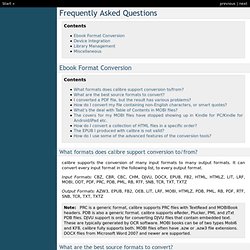
Calibre supports the conversion of many input formats to many output formats. It can convert every input format in the following list, to every output format. Input Formats: CBZ, CBR, CBC, CHM, DJVU, DOCX, EPUB, FB2, HTML, HTMLZ, LIT, LRF, MOBI, ODT, PDF, PRC, PDB, PML, RB, RTF, SNB, TCR, TXT, TXTZ. How to use interrupts with Python on the Raspberry Pi and RPi.GPIO – part 3. Multiple threaded callback interrupts in Python We’ve been learning about interrupts this week because of the brand new interrupt capabilities of RPi.GPIO.
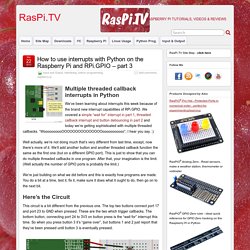
We covered a simple “wait for” interrupt in part 1, threaded callback interrupt and button debouncing in part 2 and today we’re getting sophisticated with multiple threaded callbacks. “WoooooooooOOOOOOOOOOOOOOOooooooooooo”, I hear you say. ;) Well actually, we’re not doing much that’s very different from last time, except, now there’s more of it. How to use interrupts with Python on the Raspberry Pi and RPi.GPIO – part 3. Inputs - raspberry-gpio-python - How to use inputs in RPi.GPIO - Python library for GPIO access on a Raspberry Pi. My favorites ▼ | Sign in Project Home Terms - Privacy - Project Hosting Help Powered by Google Project Hosting.
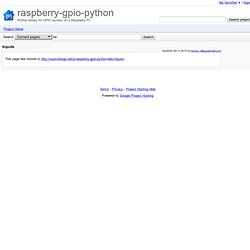
Raspberry Pi « Naich's crappy blog. These are appendixes from the set of posts about setting up and using a Raspberry Pi.

Appendix A: Selecting an IP Address As part of the boot process, your Pi used DHCP to get an IP address from the router. The problem with this is that it is an automated process which is invisible to you unless you log onto your router’s admin page to discover it. If only the Pi and your router know what its IP address is, you don’t know where to log on to your Pi. Auto-connect to wireless nets? Lizdainis wrote:pjc123 can you share your script ?
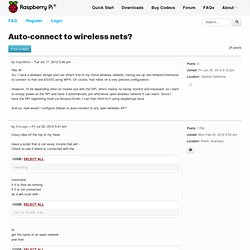
Autoconnect First of all, don't expect to just copy my scripts and expect them to magically work for your application. You might find it a lot easier to use one of the gui applications like wicd, although I don't know their capabilities. Raspberry Pi - run program at start-up. Anyway, I wanted to get my Raspberry Pi to start no-ip dynamic dns service when it started-up, so I wouldn't have to remember to start it every time it was powered up.

For details on how to install no-ip on the Pi, see this post. There are loads of ways of running a command at start-up in Linux but my favoured approach is to create an initialisation script in /etc/init.d and register it using update-rc.d. This way the application is started and stopped automatically when the system boots / shutdowns. Create script in /etc/init.d.
RPi Low-level peripherals. Back to the Hub Hardware & Peripherals: Hardware - detailed information about the Raspberry Pi boards.
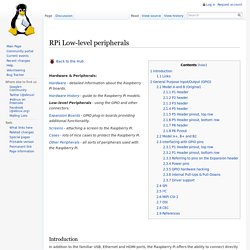
Hardware History - guide to the Raspberry Pi models. Low-level Peripherals - using the GPIO and other connectors. Bcm2835: C library for Broadcom BCM 2835 as used in Raspberry Pi. This is a C library for Raspberry Pi (RPi).

It provides access to GPIO and other IO functions on the Broadcom BCM 2835 chip, as used in the RaspberryPi, allowing access to the GPIO pins on the 26 pin IDE plug on the RPi board so you can control and interface with various external devices. It provides functions for reading digital inputs and setting digital outputs, using SPI and I2C, and for accessing the system timers. Pin event detection is supported by polling (interrupts are not supported). It is C++ compatible, and installs as a header file and non-shared library on any Linux-based distro (but clearly is no use except on Raspberry Pi or another board with BCM 2835). Project - RaspyFi - Voyage mpd on Raspberry Pi - RaspyFi Project. Dear beloved RaspyFi Users RaspyFi has evolved into Which is compatible with Raspberry Pi, Udoo, Cubox and Beaglebone Black. And brings lots of new, exciting features. RaspyFi website will remain available for archive references, every new activity will be on Volumio.org.
Passwordless SSH Using Shared Keys. This is something I use quite often to ease automated (ie, scripted) jobs that are run on a host that needs to connect to another host via SSH/SCP. Just an aside, my favorite alternative to using shared keys for (faux) passwordless connections is an expect script that "expects" a password prompt, which expect will hand back to the host. But that approach is almost always more difficult, requires an understanding of the expect language and is generally less secure. Sweet pi – sweet home - Funksteckdosen mit dem Raspberry Pi und pilight schalten. Funksteckdosen mit dem Raspberry Pi und pilight schalten Da sich hier einiges geändert hat, habe ich mich dafür entschlossen einen neuen Anleitung zum Thema Funksteckdosen schalten mit dem Raspberry Pi zu schreiben.
Das Projekt von CurlyMoo auf das sich die alte Anleitung bezogen hat wurde vom Autor CurlyMoo mittlerweile um einiges verbessert und erweitert und heißt nun pilight. Nachtrag vom 25. November 2013: Nun ist die Anleitung auf pilight 2 angepasst. Hier beschreibe ich das vorgehen für die Intertechno Funksteckdosen welche auf 433MHz Basis über Funk schaltbar sind.
Was wird zusätzlich benötigt: Die Empfänger sind nicht gerade die Besten, aber sie reichen aus (zumindest bei mir) um den Code der Fernbedienung einmalig auszulesen. 1. Zuerst muss man die für die Installation nötigen Pakete installieren: System über SSH herunterfahren › System einrichten und verwalten.